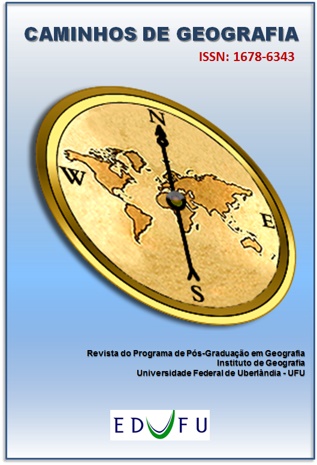PROCESAMIENTO DE DATOS SATELITALES ÓPTICOS Y DE RADAR PARA LA DETECCIÓN DE CAMBIOS MORFOMÉTRICOS: EL CASO DE LA DESEMBOCADURA DEL RÍO SAUCE GRANDE (ARGENTINA)
DOI:
https://doi.org/10.14393/RCG238658189Palavras-chave:
nuevo canal distributario, imágenes de libre acceso, variabilidad pluviométrica, cuencas hidrográficasResumo
El objetivo de este trabajo fue evaluar los cambios morfométricos de la desembocadura del río Sauce Grande (Argentina) a partir del procesamiento de datos satelitales ópticos y de radar. Se realizó un análisis visual de imágenes satelitales de alta resolución durante el período 2011-2018. Las imágenes mostraron que, en el año 2018 en la desembocadura del río, se originó un nuevo canal distributario. Para detectar la fecha de su generación, se procesaron imágenes Landsat 8 OLI-TIRS y Sentinel 1A y 1B. Se analizó la variabilidad pluviométrica para comprobar si la variación morfométrica fue originada por la precipitación. La aparición del nuevo distributario ocurrió en la semana del 7 al 13 de septiembre, producto de una precipitación torrencial y un subsiguiente período húmedo con precipitaciones intensas que duró dos meses y que no son comunes en la región. El canal fue intermitente, dado que se observó sólo hasta noviembre 2018. Las imágenes ópticas no permitieron analizar los cambios morfométricos debido a la importante nubosidad, mientras que las imágenes de radar proporcionaron la información necesaria para observar el cambio morfométrico. El método empleado es muy útil en aquellas regiones que presentan datos escasos o inexistentes y que tienen una alta cobertura nubosa.
Downloads
Downloads
Publicado
Edição
Seção
Licença
Copyright (c) 2022 Andrea Soledad Brendel, Federico Ferrrelli, Maria Florencia de Uribe Echeverria, Maria Cintia Piccolo, Gerardo Miguel Eduardo Perillo

Este trabalho está licenciado sob uma licença Creative Commons Attribution-NonCommercial-NoDerivatives 4.0 International License.
Autores que publicam nesta revista concordam com os seguintes termos: a) Autores mantém os direitos autorais e concedem à revista o direito de primeira publicação, com o trabalho licenciado sob a Creative Commons Atribuição-NãoComercial-SemDerivações 4.0 Internacional. b) Autores têm permissão e são estimulados a publicar e distribuir seu trabalho online (ex.: em repositórios institucionais ou na sua página pessoal), já que isso pode gerar alterações produtivas, bem como aumentar o impacto e a citação do trabalho publicado. c) Em virtude de aparecerem nesta revista de acesso público, os artigos são de uso gratuito, com atribuições próprias, em aplicações educacionais e não-comerciais.











